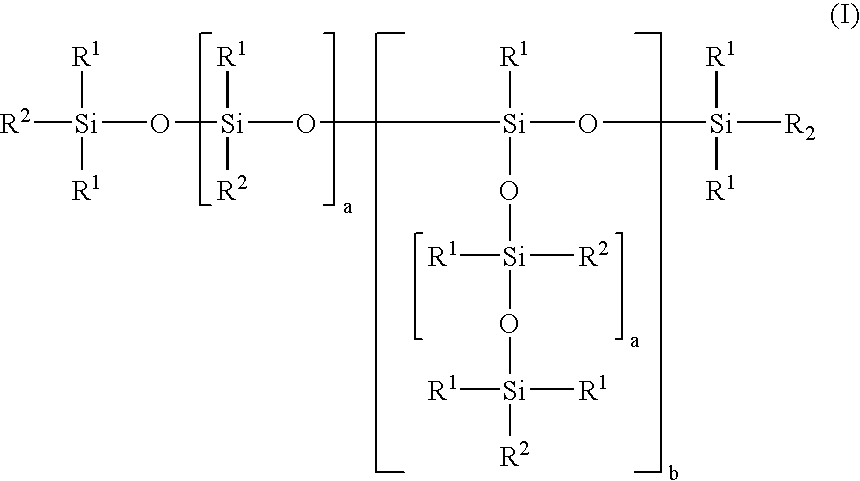Agrochemical compositions comprising alkylenediol-modified polysiloxanes
a technology of alkylenediol and polysiloxane, which is applied in the field of agrochemical compositions, can solve the problems of trisiloxane alkoxylates, undesired properties, and loss of pesticide efficacy, and achieve the effects of enhancing the performance of agrochemical compositions, increasing hydrolytic stability, and increasing hydrolytic stability
- Summary
- Abstract
- Description
- Claims
- Application Information
AI Technical Summary
Benefits of technology
Problems solved by technology
Method used
Image
Examples
example 1
Efficacy Enhancements of Fungicides by Alkylenediol-Modified Polysiloxane Surfactants
[0150] A field trial was carried out in winter wheat where ADS-1 and ADS-2 were sprayed at 0.25 l / ha in 300 l / ha water tank mixed with 0.75 l / ha of a fungicide (Opus Top of the company BASF, which contains 84 g / l epoxiconazole plus 250 g / l fenpropimorph as actives). This mixture was sprayed with nozzles to the crop at wheat growth stage 32-33 and again at growth stage 51-55. Break-Thru S233 (a commercial trisiloxane surfactant without spreading properties manufactured by Goldschmidt at 0.25 l / ha was used as internal adjuvant standards for comparison. Several assessments were carried out of the diseased leaf area, at different days after the applications. The main disease in this trial was Septoria tritici, which was assessed in terms of % infected leaf area for leaves F-3, F-1 and F. For the grain filling period of wheat, and thus for the yields, it is important to protect the leaves F-1 and F (the...
example 2
Efficacy Enhancements of Fungicides by Alkylenediol-Modified Polysiloxane Surfactants
[0152] A greenhouse experiment to study the effect of ADS on Amistar (SC 250 g / l azoxystrobin) for the control of the powdery mildew disease in barley, was carried out at the University of Giessen, Germany. Barley cultivar “Ingrid” (3 plants / pot) was grown for three weeks in a “Frustosoil”. The plants were sprayed with the treatments (see table of results) using 250 l / ha spray solution containing Amistar (250 g / l SC azoxystrobin) or / and 50 ml / ha of the adjuvant as indicated in the table of results. Two days after application 8 cm long leaf segments were cut from the plants and were placed onto benzimidazole agar (0.5% agar to which 40 ppm benzimidazole was added after sterilisation). The leaves were then inoculated with fresh conidia of Blumeria graminis f.sp. hordei (race A6) using an inoculation tower. After 7 and 14 days of incubation at room temperature the powdery mildew disease was assessed b...
example 3
Hydrolytic Stability at Extreme pH Values
[0154] Hydrolytic stability was measured in 0.1% buffer solution (pH 3:0.1 M C6H8O7 / NaOH / NaCl, pH 11: 0.1 M Boric acid / KCl / NaOH).
[0155] Stability was measured by measuring the dynamic surface tension of the solution using a tensiometer of the type ‘SITA pro line f10’ at 0.1 Hz and a bubble lifetime of 5000 ms. Hydrolysis of the siloxane results in fragments with reduced surface activity and therefore an increase in surface tension.
TABLE 3Change of dynamic surface tension(at different pH values, in mN / m)ADS-2TSE-1base28.722.0value(H2O, pH 7)(H2O, pH 7)TimepH 3pH 11pH 3pH 111 h29.031.424.724.82 h23.328.131.737.53 h28.027.548.448.84 h27.926.551.449.0
[0156] These results demonstrate that trisiloxane ethoxylate surfactants start to degrade at extreme pH values almost immediately (as shown by the increasing surface tension) while the alkylenediol-derived surfactants are stable and unchanged.
PUM
| Property | Measurement | Unit |
|---|---|---|
| particle size | aaaaa | aaaaa |
| particle sizes | aaaaa | aaaaa |
| diameter | aaaaa | aaaaa |
Abstract
Description
Claims
Application Information
 Login to View More
Login to View More - R&D
- Intellectual Property
- Life Sciences
- Materials
- Tech Scout
- Unparalleled Data Quality
- Higher Quality Content
- 60% Fewer Hallucinations
Browse by: Latest US Patents, China's latest patents, Technical Efficacy Thesaurus, Application Domain, Technology Topic, Popular Technical Reports.
© 2025 PatSnap. All rights reserved.Legal|Privacy policy|Modern Slavery Act Transparency Statement|Sitemap|About US| Contact US: help@patsnap.com



